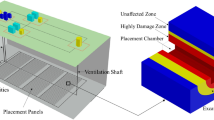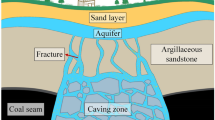Abstract
Discrete-fracture and rock matrix (DFM) modelling necessitates a physically realistic discretisation of the large aspect ratio fractures and the dissected material domains. Using unstructured spatially adaptively refined finite-element meshes, we find that the fastest flow often occurs in the smallest elements. Flow velocity and element size vary over many orders of magnitude, disqualifying global Courant number (CFL)-dependent transport schemes because too many time steps would be necessary to investigate displacements of interest. Here, we present a higher-order accurate implicit pressure–(semi)-implicit transport scheme for the advection–diffusion equation that overcomes this CFL limitation for DFM models. Using operator splitting, we solve the pressure and the transport equations on finite-element, node-centred finite-volume meshes, respectively, using algebraic multigrid methods. We apply this approach to field data-based DFM models where the fracture flow velocity and mesh refinement is 2–4 orders of magnitude greater than that of the matrix. For a global CFL of ≤10,000, this implies sub-CFL, second-order accurate behaviour in the matrix, and super-CFL, at least first-order accurate, transports in fast-flowing fractures. Their greater refinement, however, largely offsets this numerical dispersion, promoting a highly accurate overall solution. Numerical and fracture-related mechanical dispersions are compared in the realistic DFM models using second-order accurate runs as reference cases. With a CFL histogram, we establish target error criteria for CFL overstepping. This analysis indicates that for extreme fracture heterogeneity, only a few transport steps can be sufficient to analyse macro-dispersion. This makes our implicit method attractive for quick analysis of transport properties on multiple realisations of DFM models.
Similar content being viewed by others
References
Aziz K.: Reservoir simulation grids: opportunities and problems. J. Petrol. Technol. 45, 658–663 (1993)
Aziz, K., Settari, A.: Petroleum Reservoir Simulation, 476 pp. Applied Science Publishers, London (1979)
Baliga, B.R.: A control-volume based finite-element method for convective heat and mass transfer. Unpublished PhD thesis, University of Minnesota, Minneapolis (1978)
Baliga B.R., Patankar S.V.: A new finite-element formulation for convection-diffusion problems. Numer. Heat Transf. 3, 393–409 (1980)
Belayneh, M., Matthäi, S.K., Geiger, S.: Numerical simulation of water injection into layered fractured carbonate reservoir analogues. Am. Assoc. Petrol. Geol. Bull. 90, 1–21 (Oct 2006, in review)
Berkowitz B., Scher H.: Anomalous transport in random fracture networks. Phys. Rev. Lett. 79(20), 4038–4041 (1997)
Cordes C., Kinzelbach W.: Continuous groundwater velocity fields and path lines in linear, bilinear, and trilinear finite elements. Water Resour. Res. 28(11), 2903–2911 (1992)
Cortis, A., Birkholzer, J.: Continuous time random walk analysis of solute transport in fractured porous media. Water Resour. Res. 44, W06414 (2008). doi:10.1029/2007WR006596
Coumou D., Matthäi S.K., Geiger S., Driesner T.: A parallel FE-FV scheme to solve fluid flow in complex geologic media. Comput. Geosci. 34(12), 1697–1707 (2008). doi:10.1016/j.cageo.2007.11.010
Derschowitz B., LaPointe P., Eiben T., Wei L.: Integration of discrete feature network methods with conventional simulator approaches. SPE 49069, 1–10 (1998)
Durlofsky L.J.: A triangle based mixed finite element—finite volume technique for modeling two-phase flow through porous media. J. Comput. Phys. 105, 252–266 (1993)
Eikemo B., Lie K.A., Eigestad G.T., Dahle H.K.: Discontinuous Galerkin methods for advective transport in single-continuum models of fractured media. Adv. Water Resour. 32, 4 (2009)
Geiger S., Roberts S.G., Matthäi S.K., Zoppou C., Burri A.: Combining finite element and finite volume methods for efficient multi-phase flow simulation in highly heterogeneous and geometrically complex porous media. Geofluids 4, 284–299 (2004)
Gudonov S.K.: The finite-difference method for the computation of discontinuous solutions of the equations of fluid dynamics. Math. Sb. 47, 357–393 (1959)
Hoteit H., Firoozabadi A.: Multicomponent fluid flow by discontinuous Galerkin and mixed methods in unfractured and fractured media. Water Resour. Res. 41, 69–73 (2005). doi:10.1029/2005WR004339
Huber R., Helmig R.: Multi-phase flow in heterogeneous porous media: a classical finite element method versus an implicit pressure-explicit saturation-based mixed finite element-finite volume approach. Int. J. Numer. Methods Fluids 29, 899–920 (1999)
Huber R., Helmig R.: Node-centered finite volume discretizations for the numerical simulation of multiphase flow in heterogeneous porous media. Comput. Geosci. 4, 141–164 (2000)
Huyakorn P.S., Pinder G.F.: Computational Methods in Subsurface Flow. Academic Press, London (1987)
Jiang G.S., Tadmor E.: Non-oscillatory central difference schemes for multidimensional hyperbolic conservation laws. SIAM J. Sci. Comput. 18, 1892–1917 (1998)
Juanes R., Samper J., Molinero J.: A general and efficient formulation of fractures and boundary conditions in the finite-element method. Int. J. Numer. Methods Eng. 54, 1751–17774 (2002)
Karimi-Fard K., Firoozabadi A.: Numerical solution of water injection in fractured media using the discrete-fracture model and the Galerkin method. SPE Reserv. Eval. Eng. 6(2), 117–126 (2003)
LeVeque R.J.: Large time step shock-capturing techniques for scalar conservation laws. SIAM J. Numer. Anal. 19(6), 1091–1109 (1982)
LeVeque R.J.: Numerical Methods in Conservation Laws. Short Course Taught at the ETH Zürich. Birkhäuser Verlag, Basel (1987)
Matthäi, S.K., Belayneh, M.: Fluid flow partitioning between fractures and a permeable rock matrix. Geophys. Res. Lett. 31(7), 5 pp. (2004)
Matthäi, S.K., Aydin, A., Pollard, D.D., Roberts, S.G.: Simulation of transient well-test signatures for geologically realistic faults in sandstone reservoirs. SPE J. 3(1), 62–76, SPE38442 (1998)
Matthäi, S.K., Geiger, S., Roberts, S.G.: The Complex Systems Platform CSP5.0: User’s Guide, 5th edn. ETH Research Reports, 150 pp. (2004)
Matthäi S.K., Mezentsev MA, Belayneh MA.: Finite element-node-centred finite-volume two-phase-flow experiments with fractured rock represented by hybrid-element. SPE Reserv. Eval. Eng. 12, 740–756 (2007a)
Matthäi, S.K., Geiger, S., Roberts, S.G., Paluszny, A., Belayneh, M., Burri, A., Mezentsev, A., Lu, H., Coumou, D., Driesner, T., Heinrich, C.A.: Numerical simulation of multi-phase fluid flow in structurally complex reservoirs. In: Jolley, S.J., Barr, D., Walsh, J.J., Knipe, R.J. (eds.) Structurally Complex Reservoirs, vol. 292, pp. 405–429. Geological Society, London, Special Publication (2007b)
Monteagudo, J.E.P., Firoozabadi, A.: Control-volume method for numerical simulation of two-phase flow in two- and three-dimensional discrete-fractured media. Water Resour. Res. 40, W07405 (2004). doi:10.1029/2003WR002996
Mose R., Siegel P., Ackerer P.: Application of the mixed hybrid finite element approximation in a groundwater flow model: luxury or necessity?. Water Resour. Res. 30(11), 3001–3012 (1994)
Natvig J.R., Lie K.A.: Fast computation of multiphase flow in porous media by implicit discontinuous Galerkin schemes with optimal ordering of elements. J. Comput. Phys. 227(24), 10108–10124 (2008). doi:10.1016/j.jcp.2008.08.024
Nessyahu H., Tadmor E.: Non-oscillatory central differencing for hyperbolic conservation laws. J. Comput. Phys. 87, 408–463 (1988)
Nick, H.M., Schotting, R., Gutierrez-Neri, M., Johannsen, K.: Modeling transverse dispersion and variable density flow in porous media. Transp. Porous Media (2008). doi:10.1007/s11242-008-9277-x
Pain C.C., Umpleby A., de Oliveira C., Goddard A.: Tetrahedral mesh optimisation and adaptivity for steadystate and transient finite element calculations. Comput. Methods Appl. Mech. Eng. 190(29–30), 3771–3796 (2001)
Pain C.C., Eaton M.D., Bowsher J., Smedley-Stevenson R.P., Umpleby A.P., de Oliveira C.R.E., Goddard A.J.H.: Finite element based Riemann solvers for time-dependent and steady-state radiation transport. Transp. Theory Stat. Phys. 32, 699–712 (2003)
Paluszny A., Matthäi S.K., Hohmeyer H.: Hybrid finite element finite volume discretization of complex geologic structures and a new simulation workflow demonstrated on fractured rocks. Geofluids 7, 186–208 (2007)
Ruge, J.W., Stüben, K.: Algebraic multigrid. In: McCormick, S.F. (ed.) Multigrid Methods: SIAM Frontiers in Applied Mathematics, vol. 3, pp. 73–130. SIAM, Philadelphia (1987)
Stüben, K.: Algebraic Multigrid (AMG): An Introduction with Applications. GMD Report 70, 127 pp. GMD—Forschungszentrum Informationstechnik GmbH, Sankt Augustin, Germany (1999)
Thomas G.W., Thurnau D.H.: The mathematical basis for the adaptive implicit method. SPE 10495, 69–73 (1982)
Author information
Authors and Affiliations
Corresponding author
Rights and permissions
About this article
Cite this article
Matthäi, S.K., Nick, H.M., Pain, C. et al. Simulation of Solute Transport Through Fractured Rock: A Higher-Order Accurate Finite-Element Finite-Volume Method Permitting Large Time Steps. Transp Porous Med 83, 289–318 (2010). https://doi.org/10.1007/s11242-009-9440-z
Received:
Accepted:
Published:
Issue Date:
DOI: https://doi.org/10.1007/s11242-009-9440-z




